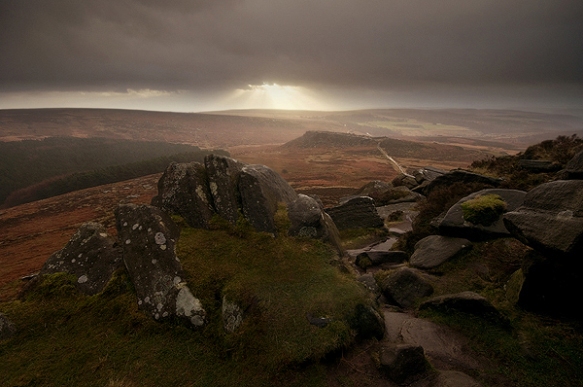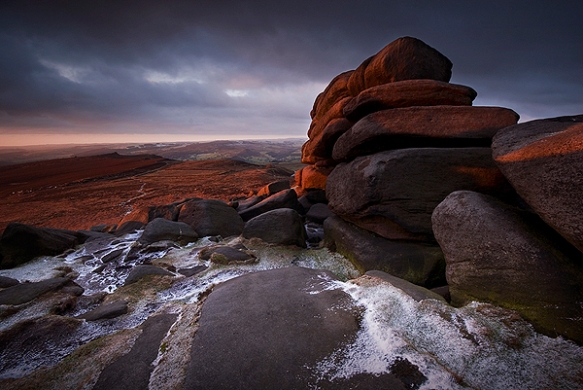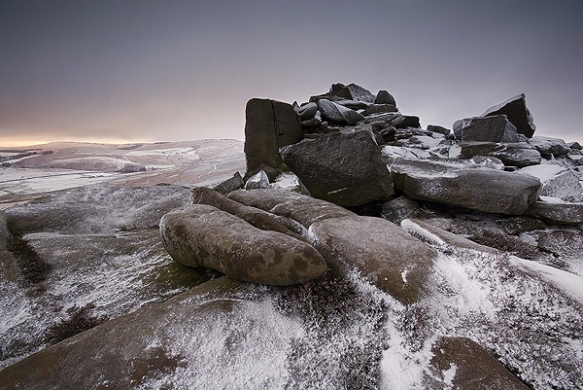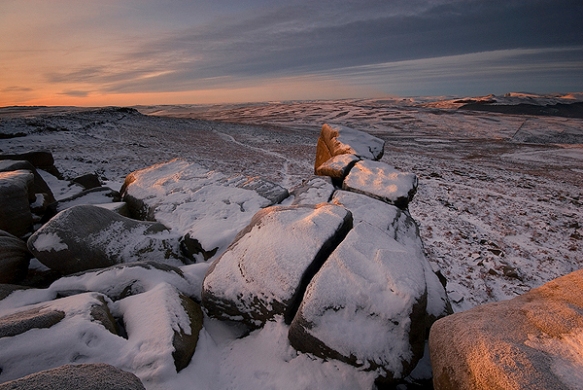It was one of those mornings when the alarm goes off and you question your own sanity. The day after Boxing Day and the rest of the world is having a lie-in, as some of the strongest winds of the year batter against my bedroom window. Still, I decide that I have to live by my own first rule of landscape photography, “you have to be there.”
Once out of the warm comfort of my bed, the internal dialogue of deciding where to go begins. I had originally fancied Whinstone Lee Tor and the Hurkling Stones on Derwent Edge, but reason with myself that by the sound of the wind, it would be far too exposed and that an easier location would be better. I manage to talk myself into a nice easy walk up onto Higger Tor. If the wind is too bad, then I’m closer to the car, rather taking a long climb on a hiding to nothing. With the fact that I’m being sensible and not just lazy justified in my mind, off I go.
As I approach Grenoside on the A61 into Sheffield, I can see a faint light and clear horizon to the east. Perhaps it isn’t going to be too bad. By the time I reach Ecclesall Road it is raining, which turns into a downpour, lashing against the car as I leave the last bits of conurbation behind on Ringinglow Road.
I pulled into the parking spot behind Higger Tor and as I open the car door, the wind yanked it from my hand. It had stopped raining but the wind was savage. I allowed myself faint self-praise for not heading for Derwent Edge, as I made the short climb up onto the tor.
There was still more than half an hour to go until sunrise. Normally, these twilight moments of dawn are my favourite time of day. On some days, the rocks seem to glow from within, but today I can hardly stand in the fierce wind, blasting across the hilltop. Most of the eastern horizon was clear and beginning to colour-up in a pale gold, but the place where I would expect the sun to rise in the south east, was bound by a bank of low cloud. I set up my tripod to see how it fared in the wind. Usually sturdy (my tripod is made of steel tubing, not a lightweight carbon fibre affair), the wind blew it over in seconds. The rain started again and while adjusting my coat hood, it took one of my gloves and flung it over the edge. I decide to shelter for a while.
The usually reliable Shelter Rock was not fit for purpose, so I headed for a little spot I know on the southern-most side of the tor. A fortunately photogenic spot with jagged rocks, over-looking Carl Wark. I scrambled down off of the top of the tor a little and set my tripod up again. It was a bit more sheltered there, so I set my camera onto the tripod and took a few shots with black and white processing in mind.
The rain was now coming in bursts, so I put my gear into a fissure in the rock-face and took shelter in there myself. Once out of the main force of the wind, it was surprisingly pleasant to watch the sheets of rain lash against Carl Wark. I’ve always thought that in order to really understand the nature of a place, you have to experience and capture it in all weathers and not just the pleasant glow of a summer’s evening.
8.20am, the time for sunrise came and went with no sign of the sun, just rain clouds scudding across the moor a few metres above my head. I could see that if I waited a bit longer, the sun would climb above the bank of cloud on the horizon and maybe produce some usable light. So I waited, occasionally venturing out of my rocky shelter for a look around, quickly retreating when reaching a spot where the wind was stronger.
About an hour after sunrise, I noticed a slight change in the light, as if it had been turned up by a notch. The sun was finally climbing high enough to poke it’s fingers through the cloud and was beginning to produce fast moving beams of light, sweeping across the moor like some celestial searchlight. The biggest challenge now was to keep the rain off of the filters, which proved impossible. I ditched the filters and opted to just use the naked lens, as it offered a smaller target area for the rain drops. This proved largely successful, but still produced some wasted shots as I had to wipe the lens between every set of brackets, so smearing became a problem.
After a while, I had exhausted the compositions in my little sheltered area and decided it was time to brave the top of the tor again, to see if I could snatch a few alternative compositions. The wind had lost none of its ferocity and just holding the camera still proved to be difficult. It didn’t take long before it became obvious that it was time to make a stumbling, rain sodden retreat back to the car.
It had been both a frustrating and exhilarating morning in equal measures. Frustrating that the conditions made capturing more compositions impossible and many of those that I did capture, were rendered unusable by water smearing on the lens. But exhilarating in that I had been there to witness to moor in all of its wind and rain lashed drama. In my opinion, I thought that the shots captured made it worthwhile. I hope that you agree. On the way home, I stopped off at a garage and bought a new pair of gloves.















